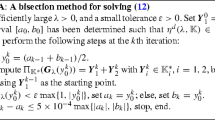Abstract
We perform a theoretical and computational study of the classical linearisation techniques (LT) and we propose a new LT for binary quadratic problems (BQPs). We discuss the relations between the linear programming (LP) relaxations of the considered LT for generic BQPs. We prove that for a specific class of BQP all the LTs have the same LP relaxation value. We also compare the LT computational performance for four different BQPs from the literature. We consider the Unconstrained BQP and the maximum cut of edge-weighted graphs and, in order to measure the effects of constraints on the computational performance, we also consider the quadratic extension of two classical combinatorial optimization problems, i.e., the knapsack and stable set problems.

Similar content being viewed by others
References
Adams, W. P., Forrester, R. J., & Glover, F. W. (2004). Comparisons and enhancement strategies for linearizing mixed 0–1 quadratic programs. Discrete Optimization, 1(2), 99–120.
Adams, W. P., & Sherali, H. D. (1986). A tight linearization and an algorithm for zero-one quadratic programming problems. Management Science, 32(10), 1274–1290.
Billionnet, A., & Soutif, E. (2004). An exact method based on lagrangian decomposition for the 01 quadratic knapsack problem. European Journal of Operational Research, 157(3), 565–575.
Caprara, A. (2008). Constrained 0–1 quadratic programming: Basic approaches and extensions. European Journal of Operational Research, 187, 1494–1503.
Caprara, A., Pisinger, D., & Toth, P. (1999). Exact solution of the quadratic knapsack problem. INFORMS Journal on Computing, 11(2), 125–137.
Chaovalitwongse, W., Pardalos, P. M., & Prokopyev, O. A. (2004). A new linearization technique for multi-quadratic 01 programming problems. Operations Research Letters, 32(6), 517–522.
Conforti, M., Cornuéjols, G., & Zambelli, G. (2010). Extended formulations in combinatorial optimization. 4OR, 8(1), 1–48.
Forrester, R., & Greenberg, H. (2008). Quadratic binary programming models in computational biology. Algorithmic Operations Research, 3(2), 110–129.
Fortet, R. (1960). L’algebre de boole et ses applications en recherche operationnelle. Trabajos de Estadistica, 11(2), 111–118.
Furini, F., & Traversi, E. (2013). Hybrid SDP bounding procedure. Lecture Notes in Computer Science, 7933, 248–259.
Glover, F. (1975). Improved linear integer programming formulations of nonlinear integer programs. Management Science, 22(4), 455–460.
Glover, F., & Woolsey, E. (1973). Further reduction of zero-one polynomial programming problems to zero-one linear programming problems. Operations Research, 21(1), 156–161.
Glover, F., & Woolsey, E. (1974). Converting the 0–1 polynomial programming problem to a 0–1 linear program. Operations Research, 22(1), 180–182.
Gueye, S., & Michelon, P. (2009). A linearization framework for unconstrained quadratic (0–1) problems. Discrete Applied Mathematics, 157(6), 1255–1266.
Hansen, P., & Meyer, C. (2009). Improved compact linearizations for the unconstrained quadratic 01 minimization problem. Discrete Applied Mathematics, 157(6), 1267–1290.
ILOG IBM. (2017). Cplex optimizer.
Jaumard, B., Marcotte, O., & Meyer, C. (1998). Estimation of the Quality of Cellular Networks Using Column Generation Techniques. Cahiers du GÉRAD. Groupe d’études et de recherche en analyse des décisions.
Krislock, N., Malick, J., & Roupin, F. (2014). Improved semidefinite bounding procedure for solving Max-Cut problems to optimality. Mathematical Programming, 143(1), 61–86.
Lodi, A. (2010). Mixed integer programming computation. In M. Jünger, T. M. Liebling, D. Naddef, G. L. Nemhauser, W. R. Pulleyblank, G. Reinelt, G. Rinaldi, & L. A. Wolsey (Eds.), 50 Years of integer programming 1958–2008 (pp. 619–645). Berlin: Springer.
Padberg, M. (1989). The boolean quadric polytope: Some characteristics, facets and relatives. Mathematical Programming, 45(1), 139–172.
Pisinger, D. (2007). The quadratic knapsack problem: A survey. Discrete Applied Mathematics, 155(5), 623–648.
Rendl, F., Rinaldi, G., & Wiegele, A. (2010). Solving max-cut to optimality by intersecting semidefinite and polyhedral relaxations. Mathematical Programming, 121(2), 307–335.
Sherali, H. D., & Adams, W. P. (1998). A reformulation-linearization technique for solving discrete and continuous nonconvex problems. Berlin: Springer.
Sherali, H. D., & Smith, J. C. (2007). An improved linearization strategy for zero-one quadratic programming problems. Optimization Letters, 1(1), 33–47.
Wang, H., Kochenberger, G., & Glover, F. (2012). A computational study on the quadratic knapsack problem with multiple constraints. Computers & Operations Research, 39(1), 3–11.
Wiegele, A. (2007). Biq mac library—A collection of max-cut and quadratic 01 programming instances of medium size. Technical report, Alpen-Adria-Universität Klagenfurt, Austria.
Acknowledgements
Thanks are due to two anonymous referees for careful reading and useful comments.
Author information
Authors and Affiliations
Corresponding author
Additional information
Publisher's Note
Springer Nature remains neutral with regard to jurisdictional claims in published maps and institutional affiliations.
Rights and permissions
About this article
Cite this article
Furini, F., Traversi, E. Theoretical and computational study of several linearisation techniques for binary quadratic problems. Ann Oper Res 279, 387–411 (2019). https://doi.org/10.1007/s10479-018-3118-2
Published:
Issue Date:
DOI: https://doi.org/10.1007/s10479-018-3118-2




